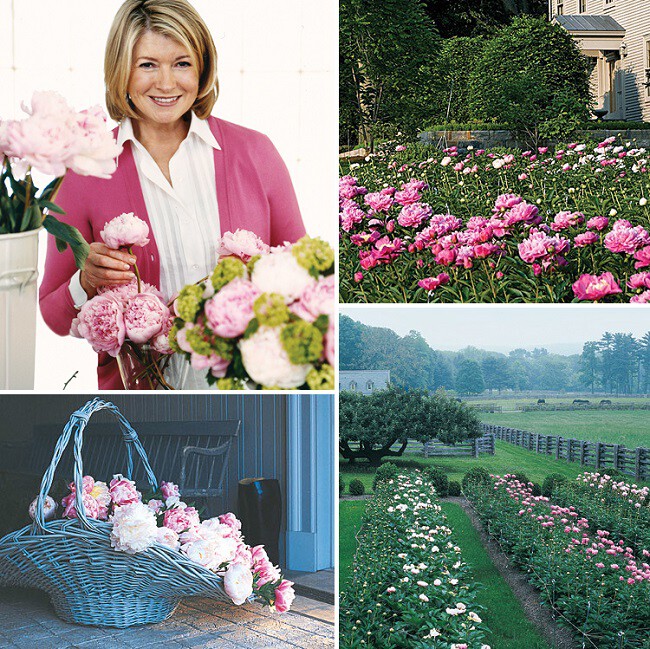In honor of peony season, learn how our founder grows these stunning blooms at her home in Bedford.

When I moved to my farm in Bedford, I vowed to rethink the way I had always gardened. I wanted to plant differently, to create masses of color and masses of a single plant type, as I never had before. My beloved six-acre garden at Turkey Hill, in Westport, had been planted fully and well: I had been influenced by Claude Monet and his colorful, lush garden in Giverny, France, and by Helena Rutherford Ely and her extraordinary garden in New Jersey (a garden I never actually saw but only read about in her books). So I planted orchards, perennial borders, and large flower beds. Because all the gardens were visible from the house and pool and outbuildings, there could never be a down period-something needed to be in bloom continuously from early spring through summer and way into fall.
In the Bedford gardens, which I began about four years ago, I had many more acres to deal with and a landscape that seemed to devour plants and shrubs and trees at a ferocious rate. I had to create a new type of design and method to deal with areas, not beds, with more mass plantings than carefully planned borders, and groupings of specific colors rather than a riot of color, as at Turkey Hill.
Having read so much more by that time than when I started gardening in Westport, my tastes and sensibilities were honed more by my botanical knowledge than by whim and a passion for lots of flowers. I zeroed in on individual species: azaleas, boxwood, epimediums, hostas, and even various trees such as sycamores and ginkgos and beeches.
I began planting in masses (you may have seen photos of my naturalized daffodils). The focus was to be plant specific, not overall garden specific, and after one great event took place, like the azalea bloom, and the flowers had faded, another mass of color would appear elsewhere, such as the herbaceous peony garden, leading the eye from one place to an entirely different location.
My new mentors were Jacques Wirtz, a Belgian landscape architect, and Elizabeth von Arnim, the Australian-born, London-educated author of books such as Elizabeth and Her German Garden and the novel The Enchanted April. (She married Count Henning von Arnim in 1891 and lived in Pomerania, on the count's vast estate.) Both designers understood vistas, quantity, and mass in a way I never had.

My peony garden could have been a folly, but, in fact, it is quite successful. There are 11 double rows of 22 varieties of peony, all purchased from Roy Klehm, owner of Klehm's Song Sparrow nursery, in Avalon, Wisconsin. I have always loved peonies of all types. In Westport, I had all colors and varieties of herbaceous peonies as well as many tree peonies. I decided to concentrate on pink varieties because I had read that von Arnim had a circle of pink peonies, 300 feet across, that her little girls adored. I consulted with Khlem to narrow the vast number of varieties listed in the pages of his catalog. We planted 35 beautiful, healthy bare-root plants in each row. I desired a long blooming period, strong and vibrant cultivars, and a range of shades of pink and types, including single, semi-double, double, and anemone-type blossoms.
We prepared the beds carefully, but it was not difficult to make the soil responsive to peony culture. This portion of the property had once been a peony border, and the former owner, a respected member of the Bedford garden club, had composted, manured, and fed the area regularly, making sure the soil had a pH of 6.5 to 7.0. And she ensured that the area would be sunny. The giant shady sugar maples were pruned up very high.
To delineate this garden from the others, I have planted a double row of round and oval boxwood around the vast beds. I expect this to grow into an undulating wall. This will guarantee that the bed will remain a focal point on the property and accentuate its importance in the overall landscape.
So many peonies! I could not wait for them to bloom. Even that first year, the bounty was much more than I had expected. So much more that I planned a peony party for the following June to celebrate an even better year. And on that warm night, despite the competition of delicious food and lively guests, the peonies were definitely the stars of the evening.
Planting Guide
Peonies are hardy and undemanding, but there are pointers to keep in mind. Peonies require a dormant period, so they do best in cooler areas, Zones 2 to 8. In Zone 8, choose early blooming cultivars. Space plants about three to four feet apart and away from competing tree roots. Established plants need only regular watering and a single annual application of low-nitrogen fertilizer. There are a variety of herbaceous peony types, from elegant simples, with as few as five petals, to lush doubles, with hundreds. The doubles are notorious for becoming top-heavy. The fewer the petals, the less rainwater the flower absorbs and the less likely it is to flop over.
Caring for Blooms
Peonies are unsurpassed as a cut flower, and their fragrance is best appreciated indoors. Flowers should be gathered in the early morning. Peonies are ready to be cut when buds begin to show color and soften and feel like firm marshmallows. Cut stems at an angle, and place in cool water. Change the water and trim the stems daily. Opening buds will last a week or more; fully unfurled blooms, a day or two.
Contrary to myth, ants are not needed for the flowers to unfurl. Shake them from the cut blooms, or wash them off with a gentle spray of water.